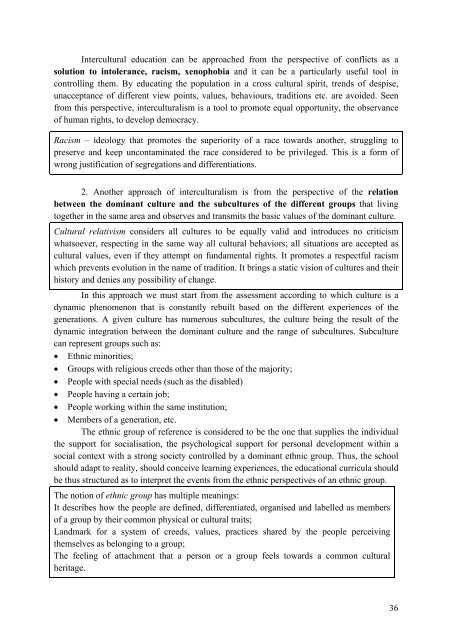Copyright © 2007, Editura ASE - BONUM
Copyright © 2007, Editura ASE - BONUM
Copyright © 2007, Editura ASE - BONUM
Create successful ePaper yourself
Turn your PDF publications into a flip-book with our unique Google optimized e-Paper software.
Intercultural education can be approached from the perspective of conflicts as a<br />
solution to intolerance, racism, xenophobia and it can be a particularly useful tool in<br />
controlling them. By educating the population in a cross cultural spirit, trends of despise,<br />
unacceptance of different view points, values, behaviours, traditions etc. are avoided. Seen<br />
from this perspective, interculturalism is a tool to promote equal opportunity, the observance<br />
of human rights, to develop democracy.<br />
Racism – ideology that promotes the superiority of a race towards another, struggling to<br />
preserve and keep uncontaminated the race considered to be privileged. This is a form of<br />
wrong justification of segregations and differentiations.<br />
2. Another approach of interculturalism is from the perspective of the relation<br />
between the dominant culture and the subcultures of the different groups that living<br />
together in the same area and observes and transmits the basic values of the dominant culture.<br />
Cultural relativism considers all cultures to be equally valid and introduces no criticism<br />
whatsoever, respecting in the same way all cultural behaviors; all situations are accepted as<br />
cultural values, even if they attempt on fundamental rights. It promotes a respectful racism<br />
which prevents evolution in the name of tradition. It brings a static vision of cultures and their<br />
history and denies any possibility of change.<br />
In this approach we must start from the assessment according to which culture is a<br />
dynamic phenomenon that is constantly rebuilt based on the different experiences of the<br />
generations. A given culture has numerous subcultures, the culture being the result of the<br />
dynamic integration between the dominant culture and the range of subcultures. Subculture<br />
can represent groups such as:<br />
• Ethnic minorities;<br />
• Groups with religious creeds other than those of the majority;<br />
• People with special needs (such as the disabled)<br />
• People having a certain job;<br />
• People working within the same institution;<br />
• Members of a generation, etc.<br />
The ethnic group of reference is considered to be the one that supplies the individual<br />
the support for socialisation, the psychological support for personal development within a<br />
social context with a strong society controlled by a dominant ethnic group. Thus, the school<br />
should adapt to reality, should conceive learning experiences, the educational curricula should<br />
be thus structured as to interpret the events from the ethnic perspectives of an ethnic group.<br />
The notion of ethnic group has multiple meanings:<br />
It describes how the people are defined, differentiated, organised and labelled as members<br />
of a group by their common physical or cultural traits;<br />
Landmark for a system of creeds, values, practices shared by the people perceiving<br />
themselves as belonging to a group;<br />
The feeling of attachment that a person or a group feels towards a common cultural<br />
heritage.<br />
36


